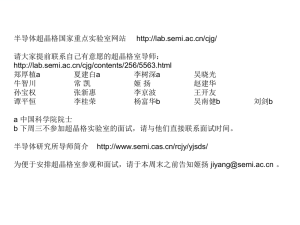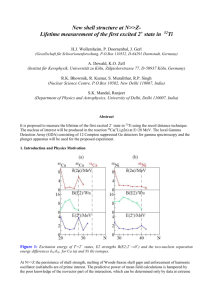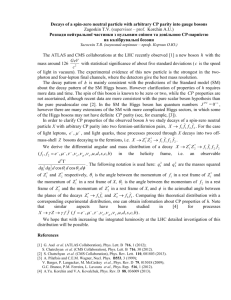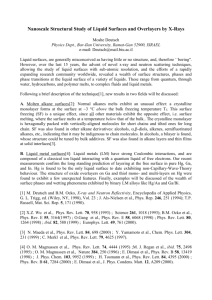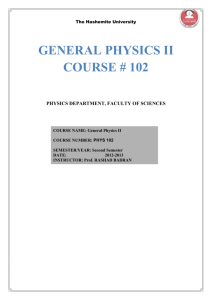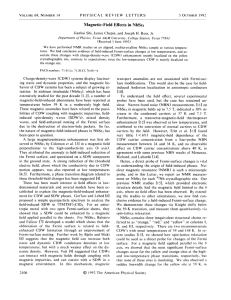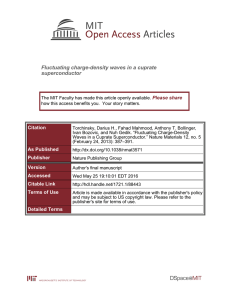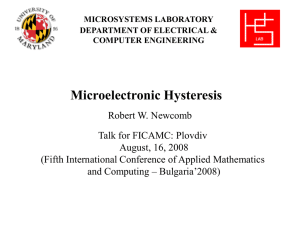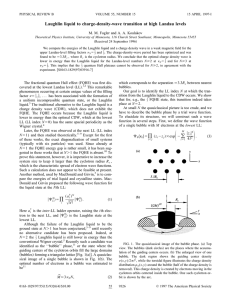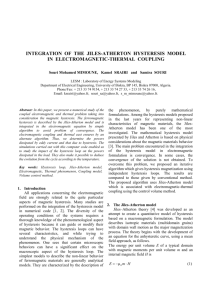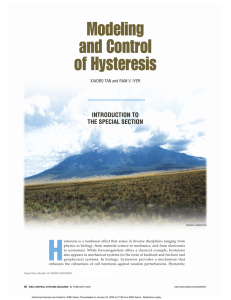Supplemental Materials
advertisement
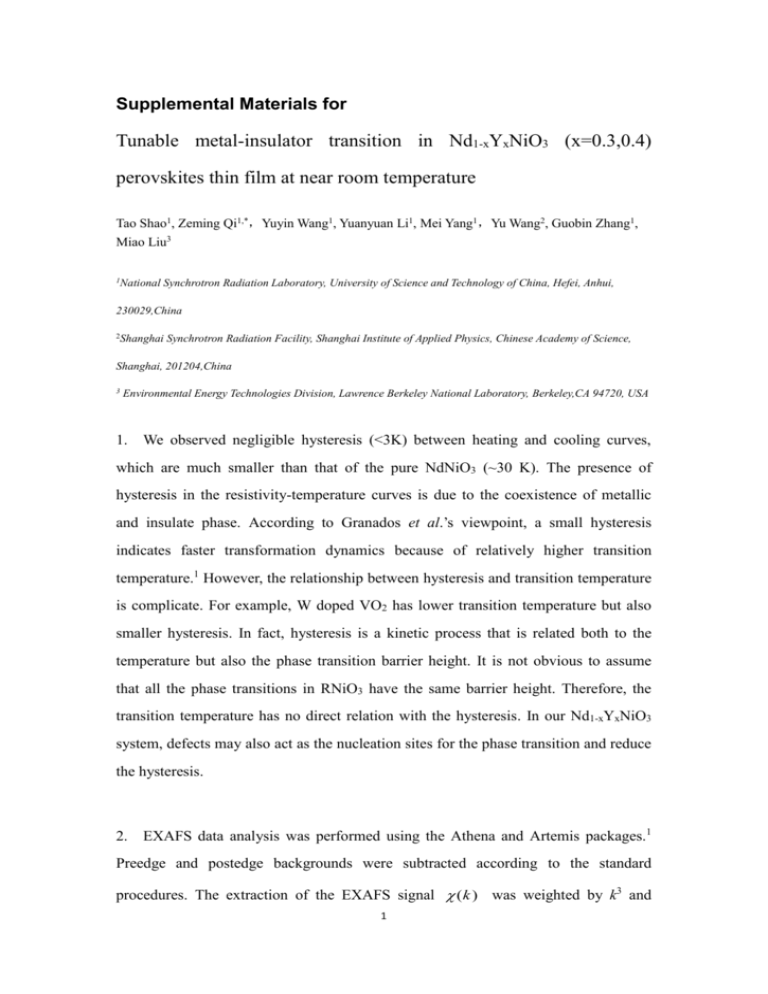
Supplemental Materials for Tunable metal-insulator transition in Nd1-xYxNiO3 (x=0.3,0.4) perovskites thin film at near room temperature Tao Shao1, Zeming Qi1,*,Yuyin Wang1, Yuanyuan Li1, Mei Yang1,Yu Wang2, Guobin Zhang1, Miao Liu3 1National Synchrotron Radiation Laboratory, University of Science and Technology of China, Hefei, Anhui, 230029,China 2Shanghai Synchrotron Radiation Facility, Shanghai Institute of Applied Physics, Chinese Academy of Science, Shanghai, 201204,China 3 Environmental Energy Technologies Division, Lawrence Berkeley National Laboratory, Berkeley,CA 94720, USA 1. We observed negligible hysteresis (<3K) between heating and cooling curves, which are much smaller than that of the pure NdNiO3 (~30 K). The presence of hysteresis in the resistivity-temperature curves is due to the coexistence of metallic and insulate phase. According to Granados et al.’s viewpoint, a small hysteresis indicates faster transformation dynamics because of relatively higher transition temperature.1 However, the relationship between hysteresis and transition temperature is complicate. For example, W doped VO2 has lower transition temperature but also smaller hysteresis. In fact, hysteresis is a kinetic process that is related both to the temperature but also the phase transition barrier height. It is not obvious to assume that all the phase transitions in RNiO3 have the same barrier height. Therefore, the transition temperature has no direct relation with the hysteresis. In our Nd1-xYxNiO3 system, defects may also act as the nucleation sites for the phase transition and reduce the hysteresis. 2. EXAFS data analysis was performed using the Athena and Artemis packages.1 Preedge and postedge backgrounds were subtracted according to the standard procedures. The extraction of the EXAFS signal (k ) was weighted by k3 and 1 Fourier transformed to R space (insert in Fig.4). The first peak corresponds to the Ni-O coordination shell. The second and third peaks can be attributed to the second nearest Ni-Nd(Y) shell and the third nearest Ni-Ni shell, respectively. To obtain quantitative results, a nonlinear least-squares routine was carried out based on the EXAFS equation2 (k ) S02 N j Fj (k , ) j sin[2k R j j (k )] kR 2 j e 2 R j / 2 2 k 2 e Where S0 is the many-body amplitude reduction factor, Nj is coordination number of the j shell. Rj is the corresponding average interatomic distance of the j shell, σ is the mean-square relative displacement. λ is the photoelectron mean free path. Fj and Φj are the effective scattering amplitude and phase shift respectively, which were obtained by calculation using Feff package based on the one-electron real space full-multiple-scattering theory.3 The fitting result of the nearest Ni-O shell is given in Table S1. It is clear that more Y atoms induced results in larger disorder in Ni-O shell. Table S1. Local structure parameters of Ni-O shell for Nd1-xYxNiO3 thin films at different temperature. Sample Coordination Bond length numbers(N) RNi-O (Å) σ2(Å2) Nd0.7Y0.3NiO3(300K) 5.6 1.94 0.0059 Nd0.7Y0.3NiO3(570K) 5.5 1.94 0.0039 Nd0.6Y0.4NiO3(300K) 5.5 1.96 0.0081 Nd0.6Y0.4NiO3(570K) 5.4 1.93 0.0068 3. The trend of transition temperature based on the prediction of charge density wave (CDW) is in good with our experimental result. According to Holstain's CDW 2 model, the CDW potential energy is proportional to the charge disproportionate between nearest neighbor sites.4 The larger charge disproportionation in x=0.4 sample increases the CDW potential energy and results in higher transition temperature. On the other hand, the transition sharpness should become more pronounced when the CDW potential energy goes to larger magnitude.5 However,in reality, transition sharpness can be affected by many possible reasons, e.g., thin film growth condition, the substrate, doping, strain, electric-field, etc.6-10 In our case, we have observed that the transition sharpness decreases with the increase the Y atoms concentration from x=0.3 to x=0.4. Similar trend have also been observed in several other solid solution nickelate systems like Nd1-xEuxO3 11, SmxNd1-xNiO312, as well as W-doped VO2 thin film.13 It is likely that such discrepancy attributes to the doping-induced inhomogeneity within the sample, such as the strain relaxation, oxygen deficiency, 2 secondary phase, etc.14 Our EXAFS analysis exhibits that the disorder factor of x=0.4 sample, which is 0.0081, is noticeably larger than that of x=0.3 sample (0.0059), indicating that transition sharpness broadening comes along with structural disorder within the sample. Therefore, in our case, the dependence of transition sharpness on Y atom concentration becomes complex and is not influenced by CDW potential energy solely. The other factors such as the strain relation, oxygen deficiency or secondary phase should also be considered.14 Hence, charge disproportionation and sample inhomogeneous are competing with each other on modifying the MIT sharpness. Reference 1 X. Granados, J. Fontcuberta, X. Obradors, and J. B. Torrance, Phys. Rev. B 46 (24), 15683 (1992). 2 B. Ravel and M.Newville , J. Synchrotron Radiat. 12 (2005) 537. 3 J. J. Rehr, R. C. Albers, Rev. Mod.Phys. 72 (2000) 621-892 4 Ankudinov A. L., Bouldin C., Rehr J. J., Sims J.and Hung H., Phys. Rev. B, 65 (2002) 104107. 3 5 6 H. T. Kim, Phys. Rev. B 54 (1), 90 (1996). H. T. Kim, B. G. Chae, D. H. Youn, S. L. Maeng, G. Kim, K. Y. Kang, and Y. S. Lim, New J. Phys, 6 (2004). 7 D. Kaur, J. Jesudasan, and P. Raychaudhuri, Solid State Commun. 136 (6), 369 (2005) 8 G. Catalan, R. M. Bowman, and J. M. Gregg, Phys.Rev. B 62 (12), 7892 (2000) 9 A. Tiwari, C.Jin and J.Narayan, 10 11 Appl.Phys.Lett.,80,4039, (2002); G.H. Aydogdu, S.D.Ha, et al. J.Appl.Phys.,109,124110,(2011); Raoul Scherwitzl, Pavlo Zubko, et al. Adv.Mater. 22,5517,(2010). 12 F. Capon, P. Laffez, et al., Appl. Phys. Lett. 81 (4), 619 (2002) 13 A.Ambrosini, J.F. hamet et al. Appl.Phys.Lett,82,727 (2003) 14 Keisuke Shibuya, Masashi Kawasaki et al. Appl.Phys.Lett., 96, 022102, (2010) 15 X.K.Lian, F.Chen, X.L.Tan et al. AIP Advances, 3, 062133 (2013) 4

